Analysis of Urban Greening Scenarios for Improving Outdoor Thermal Comfort in Neighbourhoods of Lecce (Southern Italy)
Abstract
:1. Introduction
2. Materials and Methodology
2.1. Study Area: An Overview on Lecce City
2.2. Description of the Neighbourhoods
- Santa Rosa has a dimension of 300 m × 300 m, with two street canyons (highlighted in red in Figure 2) with an aspect ratio H/W (where H is the mean height of the buildings and W the mean width of the street) equal to 0.6. The neighbourhood is characterized by buildings heights ranging from 8 m to 26 m with an average height of 13 m. The street canyon “a” is 172 m long and about 25 m wide, and it is characterized by two lateral rows of 20 trees of Quercus ilex L. (evergreen species) with an average height of 10 m, a 5 m high and wide crown, and a LAD of 0.71 m2/m3; they are planted along a concrete pavement with a small flowerbed for each; the street canyon “b” has some side openings and it is 118 m long; it is characterized by a central row of Tilia sp. (deciduous species) with an average height of 15 m, a 6 m high and 7 m wide crown, and a LAD of 1.00 m2/m3. Overall, the area is characterized by a great variety of greening:
- -
- in Santa Rosa Square (highlighted in yellow in Figure 2), there is an aggregate of trees including Pinus halepensis Mill., Prunus armeniaca L., Ceratonia siliqua L., Pittosporum tobira (Thunb.) W.T. Aiton.;
- -
- in the street parallel to the street canyon “a” (located on the left), there is a row of Cercis siliquastrum L. and several Pinus halepensis Mill. and Quercus ilex L., as well as a Platanus hybrida Brot. and an individual of Grevillea robusta A.Cunn. ex R.Br.
- Libertini has a dimension of 250 m × 300 m and is characterized by a 180 m long and 25 m wide street canyon (highlighted in red in Figure 2), with an aspect ratio H/W of 0.75 and two lateral rows of Quercus ilex L. with a LAD of 0.40 m2/m3 and a 5 m wide crown. The buildings heights range from 11 m to 16 m with an average height of 13 m. Some trees of Pinus halepensis Mill. and 2 of Lagunaria patersonia (Andrews) G. Don. are present in Libertini Square (to the left side of the street canyon), 3 Ficus rubiginosa Desf. ex Vent. in an area before the square at the bottom of the map, and 10 Quercus ilex L. in a large area (highlighted in yellow in Figure 2) characterised mainly by unirrigated turfs.
2.3. Scenarios Investigated
- in Santa Rosa, part of the cemented area was converted into a green area (grass), specifically 1117 m2 of which 220 m2 is in Santa Rosa Square, and 610 m2 is distributed on both sides of the street canyon “a” where the Quercus ilex L. flowerbed was extended, and the remaining ones in other small areas of the area. In street canyon “b”, five trees of Tilia sp. (149 m2, with the same characteristic of the others already present in the area) were added;
- in Libertini, according of the same criteria, 1011 m2 of green area (grass) replaced the concrete surface and specifically 434 m2 in the square (highlighted in yellow in Figure 2), 216 m2 along the street canyon “a” where the Quercus ilex L. flowerbed was extended, and the remaining ones in other small portions of the area. Moreover, in the highlighted square, 17 new trees with a conic crown with a LAD of 2.3 m2/m3 (977 m2) were added. Another seven were added in Libertini Square.

2.4. Model Description and Simulation Set-Up
2.5. Micrometeorological Measurements
2.6. Calculated and Analyzed Parameters
- HRPPMV = Heat Reduction Potential in terms of thermal comfort (%)
- PMVSAt = PMV in the selected area with trees
- PMVSAwt = PMV in selected area without trees
- PMVAAWT = PMV in the whole area without trees
3. Results
3.1. Model Validation
3.2. Temporal Profiles of Air Temperature
- Santa Rosa: Comparing the no greening scenario with the current one, the Tair average daily decrease is about 0.55 °C at all points, with a maximum decrease of 0.92 °C recorded at 15:00 at P1. At P2, the maximum decrease is 0.60 °C at 16:00; at P3 it is 0.68 °C at 18:00; and at P4 it is 0.73 °C at 18.00. Looking at the modified scenario, the Tair average daily decrease is more variable between the points; it is about 1.00 °C at P1 and P4, 0.68 °C at P2, and 0.55 °C at P3. On average, it is higher than the current one by about 0.25 °C. The maximum decrease of 1.10 °C is recorded at 15:00 at P1. At P2, the maximum decrease is 0.84 °C at 20:00; at P3 is 0.71 °C at 18:00; and at P4 it is 1.18 °C at 16:00. So, in general, it is possible to observe a maximum decrease in the presence of trees in the central hottest hours of the day;
- Libertini: Comparing the no-greening scenario with the current one, the Tair average daily decrease is about 0.25 °C in all points and it is more evident at P2 (street canyon) where the maximum decrease of 0.57 °C is recorded at 10:00. At P1 and P3, the maximum decrease is 0.15 °C at 16:00. As for Santa Rosa, looking at the modified scenario, the Tair average daily decrease is more variable between the points; it is about 0.74 °C at P2, 0.61 °C at P1, and 0.34 °C at P3. On average, it is higher than the current one by about 0.35 °C. The maximum decrease of 1.00 °C is recorded at P3 at 18:00. At P2, it is 0.95 °C at 20:00 and at P1 it is 0.38 °C at 18:00.
3.3. Spatial Distribution of Mean Radiant Temperature and Predictive Mean Vote
- on observing the spatial averages during the hot hours of the day (12:00, 16:00), the presence of trees induces a decrease of MRT in both Santa Rosa and Libertini. This decrease is most pronounced at 16:00, where it possible to observe a spatially averaged (average) decrease of 3.63 °C and 4.35 °C in the current and modified scenario in Santa Rosa, respectively, and 2.16 °C and 5.53 °C in Libertini. It is therefore also observable that there is a clear improvement in the modified scenario compared to the current one equal to 0.72 °C in Santa Rosa and 3.37 °C in Libertini;
- on observing the spatial averages at 20:00, the decrease of MRT in the presence of trees is less marked, and nil in the current scenario in Libertini. Specifically, the spatial average is strongly influenced by what occurs in areas where the greening is most present. In fact, in the presence of trees, there is a localised increase in the street canyons in Santa Rosa, which is more evident in the street canyon “b” (≃1 °C) in both current and modified scenarios. In Libertini, it is possible to see that this increase in the street canyon “a” in the current scenario (≃0.60 °C) is less evident in the modified one, where there instead appears to be an increase in the investigated square and where new trees with high LAD were added (≃2 °C).
- there does not appear to be much difference between 12:00 and 16:00, although in this case, even an improvement in the modified scenario compared to the current one is noteworthy. In both Santa Rosa and Libertini, the maximum decrease is at 16:00 and is 0.35 and 0.53 respectively. The PMV decrease is strongest in the street canyon “b” in Santa Rosa and it appears localized where the trees are in Libertini;
- the improvement in thermal comfort at 20:00 is visible over the whole area but the rate of decrease of PMV is reduced compared to daylight hours. In Santa Rosa the decrease is almost unchanged between the current scenario and the modified one and is about 0.10, while in Libertini it is almost zero in the current scenario and equal to 0.10 in the modified one.
4. Discussion
4.1. Day-Time Hours of a Typical Summer Day
- HRP index in the street canyons “a” of Santa Rosa and Libertini are characterised by similar aspect ratios and by the presence of a double lateral row of Quercus ilex L. with similar crown geometry (5 m high and wide crown) and LAD equal to 0.71 m2/m3 in Santa Rosa and 0.40 m2/m3 in Libertini. The greening induces a greater thermal comfort in Santa Rosa, with a maximum percentage of improvement at 16:00 equal to 15% in the current scenario and to 20% in the modified one, compared to 6% and 11% in the current and modified scenario, respectively, of Libertini. Libertini is denser and located in the city centre where the air recirculation is expected to be worse than at the edge of the city (where Santa Rosa is located); the presence of trees in already dense areas was shown to worsen the street canyon ventilation in some circumstances [7,18], and thus, in this case, the positive effect of trees in improving thermal comfort is counterbalanced by the heat trapping effect;
- HRP index of the street canyon “b” of Santa Rosa and San Pio (see Gatto et al. [1]) characterised by similar aspect ratios and by the presence of Tilia sp. with a 7 m wide crown and a LAD of 1 m2/m3 in Santa Rosa and a 3 m wide crown and a LAD of 0.3 m2/m3 in San Pio. For the current scenario in Santa Rosa and the modified scenario in San Pio, both with a central row of Tilia sp., an HRP value of 23% and 4% were recorded, respectively;
- HRP index in the modified scenario compared to the current one in the investigated square of Libertini: by adding 17 new trees with a conic crown with a LAD of 2.3 m2/m3 (+977 m2 of green space), an improvement of 11% is noteworthy;
- shading effect in street canyons and squares: The effect is enhanced in denser geometries. For the same reason, in general, the effect of greening is found to be larger in street canyons rather than in the squares; further, in Santa Rosa Square, the thermal comfort improvement (in terms of both MRT and PMV) is smaller than in street canyons due to the presence of Pinus halepensis Mill., which has a smaller shade projection effect than that provided by Quercus sp. [32,33];
- ventilation: the wind direction is 210°, which is a parallel to the street canyon “a” in Santa Rosa and oblique to the street canyon “a” in Libertini. This promotes better heat dispersion in Santa Rosa and thus explains the better HRP compared with Libertini neighbourhood;
- evapotranspiration effect: Tair decrease and thermal comfort improvement in the presence of trees is also due to the evapotranspiration effect, which helped cool the air, as already observed in other studies [5]. This decrease is consistent with results obtained in other Italian cities (Teramo, Rome, Palermo, Avola, Perugia), where, in the presence of greening, a decrease in the range between 0.5 °C and 3.0 °C was observed [34,35,36,37,38];
- replacing the asphalt surface with grass contributes to reduced MRT of about 0.50 °C.
4.2. Evening-Time Hours of a Typical Summer Day
5. Conclusions
Author Contributions
Funding
Institutional Review Board Statement
Informed Consent Statement
Data Availability Statement
Conflicts of Interest
References
- Gatto, E.; Buccolieri, R.; Aarrevaara, E.; Ippolito, F.; Emmanuel, R.; Perronace, L.; Santiago, J.L. Impact of Urban Vegetation on Outdoor Thermal Comfort: Comparison between a Mediterranean City (Lecce, Italy) and a Northern European City (Lahti, Finland). Forests 2020, 11, 228. [Google Scholar] [CrossRef] [Green Version]
- Salbitano, F.; Borelli, S.; Conigliaro, M.; Chen, Y. FAO “Guidelines on Urban and Peri-Urban Forestry”; FAO Forestry Paper No. 178; Food and Agriculture Organization of the United Nations: Rome, Italy, 2017. [Google Scholar]
- Santamouris, M.; Ban-Weiss, G.; Osmond, P.; Paolini, R.; Synnefa, A.; Cartalis, C.; Muscio, A.; Zinzi, M.; Morakinyo, T.E.; Ng, E.; et al. Progress in urban greenery mitigation science–assessment methodologies advanced technologies and impact on cities. J. Civ. Eng. Manag. 2018, 24, 638–671. [Google Scholar] [CrossRef] [Green Version]
- Semeraro, T.; Scarano, A.; Buccolieri, R.; Santino, A.; Aarrevaara, E. Planning of Urban Green Spaces: An Ecological Perspective on Human Benefits. Land 2021, 10, 105. [Google Scholar] [CrossRef]
- Salmond, J.A.; Tadaki, M.; Vardoulakis, S.; Arbuthnott, K.; Coutts, A.; Demuzere, M.; Dirks, K.N.; Heaviside, C.; Lim, S.; Macintyre, H. Health and climate related ecosystem services provided by street trees in the urban environment. Environ. Health 2016, 15, S36. [Google Scholar] [CrossRef] [Green Version]
- Aram, F.; Higueras Garcìa, E.; Solgi, E.; Mansournia, S. Urban green space cooling effect in cities. Heliyon 2018, 5, e01339. [Google Scholar] [CrossRef] [PubMed] [Green Version]
- Buccolieri, R.; Santiago, J.L.; Rivas, E.; Sanchez, B. Review on urban tree modelling in CFD simulations: Aerodynamic, deposition and thermal effects. Urban For. Urban Green. 2018, 31, 212–220. [Google Scholar] [CrossRef]
- Janhäll, S. Review on urban vegetation and particle air pollution—Deposition and dispersion. Atmos. Environ. 2015, 105, 130–137. [Google Scholar] [CrossRef]
- Abhijith, K.V.; Kumar, P.; Gallagher, J.; McNabola, A.; Baldauf, R.; Pilla, F.; Broderick, B.; Di Sabatino, S.; Pulvirenti, B. Air pollution abatement performances of green infrastructure in open road and built-up street canyon environments—A review. Atmos. Environ. 2017, 162, 71–86. [Google Scholar] [CrossRef]
- Santiago, J.-L.; Rivas, E.; Sanchez, B.; Buccolieri, R.; Martin, F. The Impact of Planting Trees on NOx Concentrations: The Case of the Plaza de la Cruz Neighborhood in Pamplona (Spain). Atmosphere 2017, 8, 131. [Google Scholar] [CrossRef] [Green Version]
- Buccolieri, R.; Jeanjean, A.P.R.; Gatto, E.; Leigh, R.J. The impact of trees on street ventilation, NOx and PM2.5 concentrations across heights in Marylebone Rd street canyon, central London. Sustain. Cities Soc. 2018, 41, 227–241. [Google Scholar] [CrossRef]
- Tomson, M.; Kumar, P.; Barwise, Y.; Perez, P.; Forehead, H.; French, K.; Morawska, L.; Watts, J.W. Green infrastructure for air quality improvement in street canyons. Environ. Int. 2021, 146, 106288. [Google Scholar] [CrossRef] [PubMed]
- Yang, Y.; Gatto, E.; Gao, A.; Buccolieri, R.; Morakinyo, T.E.; Lan, H. The “plant evaluation model” for the assessment of the impact of vegetation on outdoor microclimate in the urban environment. Build. Environ. 2019, 159, 106151. [Google Scholar] [CrossRef]
- Tsoka, S.; Tsikaloudaki, A.; Theodosiou, T. Analyzing the ENVI-met microclimate model’s performance and assessing cool materials and urban vegetation applications—A review. Sustain. Cities Soc. 2018, 43, 55–76. [Google Scholar] [CrossRef]
- Giorgi, F.; Lionello, P. Climate change projections for the Mediterranean region. Glob. Planet Chang. 2008, 63, 90–104. [Google Scholar] [CrossRef]
- Lionello, P.; Abrantes, F.; Congedi, L.; Dulac, F.; Gacic, M.; Gomis, D.; Goodess, C.; Hoff, H.; Kutiel, H.; Luterbacher, J.; et al. Introduction: Mediterranean climate: Background information. In The Climate of the Mediterranean Region: From the Past to the Future; Lionello, P., Ed.; Elsevier: Amsterdam, The Netherlands, 2012; pp. xxxv–xc. [Google Scholar]
- Maggiotto, G.; Buccolieri, R.; Santo, M.A.; Leo, L.S.; Di Sabatino, S. Validation of temperature-perturbation and CFD-based modelling for the prediction of the thermal urban environment: The Lecce (IT) case study. Environ. Model. Softw. 2014, 60, 69–83. [Google Scholar] [CrossRef]
- Di Sabatino, S.; Buccolieri, R.; Pappaccogli, G.; Leo, L.S. The effects of trees on micrometeorology in a real street canyon: Consequences for local air quality. Int. J. Environ. Pollut. 2015, 58, 100–111. [Google Scholar] [CrossRef]
- Martinelli, L.; Matzarakis, A. Influence of height/width proportions on the thermal comfort of courtyard typology for Italian climate zones. Sustain. Cities Soc. 2017, 29, 97–106. [Google Scholar] [CrossRef]
- Matzarakis, A.F.; Rutz, H. Mayer Modelling radiation fluxes in simple and complex environments: Application of the RayMan model. Int. J. Biometeorol. 2007, 51, 323–334. [Google Scholar] [CrossRef]
- Buccolieri, R.; Gatto, E.; Manisco, M.; Ippolito, F.; Santiago, J.L.; Gao, Z. Characterization of Urban Greening in a District of Lecce (Southern Italy) for the Analysis of CO2 Storage and Air Pollutant Dispersion. Atmosphere 2020, 11, 967. [Google Scholar] [CrossRef]
- Tominaga, Y.; Mochida, A.; Yoshie, R.; Kataoka, H.; Nozu, T.; Yoshikawa, M.; Shirasawa, T. AIJ guidelines for practical applications of CFD to pedestrian wind environment around buildings. J. Wind. Eng. Ind. Aerodyn. 2008, 96, 1749–1761. [Google Scholar] [CrossRef]
- Lee, H.; Mayer, H. Validation of the mean radiant temperature simulated by the RayMan software in urban environments. Int. J. Biometeorol. 2016, 60, 1775–1785. [Google Scholar] [CrossRef]
- Liu, Z.; Cheng, W.; Jim, C.Y.; Morakinyo, T.E.; Shi, Y.; Ng, E. Heat mitigation benefits of urban green and blue infrastructures: A systematic review of modeling techniques, validation and scenario simulation in ENVI-met V4. Build. Environ. 2021, 200, 107939. [Google Scholar] [CrossRef]
- Morakinyo, T.E.; Ouyang, W.; Ka-Lun Lau, K.; Ren, C.; Ng, E. Right tree, right place (urban canyon): Tree species selection approach for optimum urban heat mitigation—Development and evaluation. Sci. Total Environ. 2020, 719, 137461. [Google Scholar] [CrossRef]
- Di Sabatino, S.; Buccolieri, R.; Olesen, H.R.; Ketzel, M.; Berkowicz, R.; Franke, J.; Schatzmann, M.; Schlunzen, K.; Leitl, B.; Britter, R.; et al. COST 732 in practice: The MUST model evaluation exercise. Int. J. Environ. Pollut. 2011, 44, 403–418. [Google Scholar] [CrossRef] [Green Version]
- Feyisa, G.L.; Dons, K.; Meilby, H. Efficiency of parks in mitigating urban heat island effect: An example from Addis Ababa. Landsc. Urban Plan. 2014, 123, 87–95. [Google Scholar] [CrossRef]
- Sodoudi, S.; Zhang, H.; Chi, X.; Müller, F.; Li, H. The influence of spatial configuration of green areas on microclimate and thermal comfort. Urban For. Urban Green. 2018, 34, 85–96. [Google Scholar] [CrossRef]
- Wang, J.; Guo, W.; Wang, C.; Yao, Y.; Kou, K.; Xian, D.; Zhang, Y. Tree crown geometry and its performances on human thermal comfort adjustment. J. Urban Manag. 2021, 10, 16–26. [Google Scholar] [CrossRef]
- Thorsson, S.; Lindberg, F.; Eliasson, I.; Holmer, B. Different methods for estimating the mean radiant temperature in an outdoor urban setting. Int. J. Clim. 2007, 27, 1983–1993. [Google Scholar] [CrossRef]
- Morakinyo, T.E.; Kong, L.; Lau, K.-L.; Yuan, C.; Ng, E. A study on the impact of shadow-cast and tree species on in-canyon and neighborhood’s thermal comfort. Build. Environ. 2017, 115, 1–17. [Google Scholar] [CrossRef]
- Karimi, A.; Sanaieian, H.; Farhadi, H.; Norouzian-Maleki, S. Evaluation of the thermal indices and thermal comfort improvement by different vegetation species and materials in a medium-sized urban park. Energy Rep. 2020, 6, 1670–1684. [Google Scholar] [CrossRef]
- Colter, K.R.; Middel, A.C.; Martin, C.A. Effects of natural and artificial shade on human thermal comfort in residential neighborhood parks of Phoenix, Arizona, USA. Urban For. Urban Green. 2019, 44, 126429. [Google Scholar] [CrossRef]
- Ambrosini, D.; Galli, G.; Mancini, B.; Nardi, I.; Sfarra, S. Evaluating Mitigation Effects of Urban Heat Islands in a Historical Small Center with the ENVI-Met® Climate Model. Sustainability 2014, 6, 7013–7029. [Google Scholar] [CrossRef] [Green Version]
- Battista, G.; Pastore, E.M.; Mauri, L.; Basilicata, C. Green roof effects in a case study of Rome (Italy). Energy Procedia 2016, 101, 1058–1063. [Google Scholar] [CrossRef]
- Pastore, L.; Corrao, R.; Heiselberg, P.K. The effects of vegetation on indoor thermal comfort: The application of a multi-scale simulation methodology on a residential neighborhood renovation case study. Energy Build. 2017, 146, 1–11. [Google Scholar] [CrossRef]
- Evola, G.; Gagliano, A.; Fichera, A.; Marletta, L.; Martinico, F.; Nocera, F. UHI effects and strategies to improve outdoor thermal comfort in dense and old neighbourhoods. Energy Procedia 2017, 134, 692–701. [Google Scholar] [CrossRef]
- Piselli, C.; Castaldo, V.; Pigliautile, I.; Pisello, A.; Cotana, F. Outdoor comfort conditions in urban areas: On citizens’ perspective about microclimate mitigation of urban transit areas. Sustain. Cities Soc. 2018, 39, 16–36. [Google Scholar] [CrossRef]
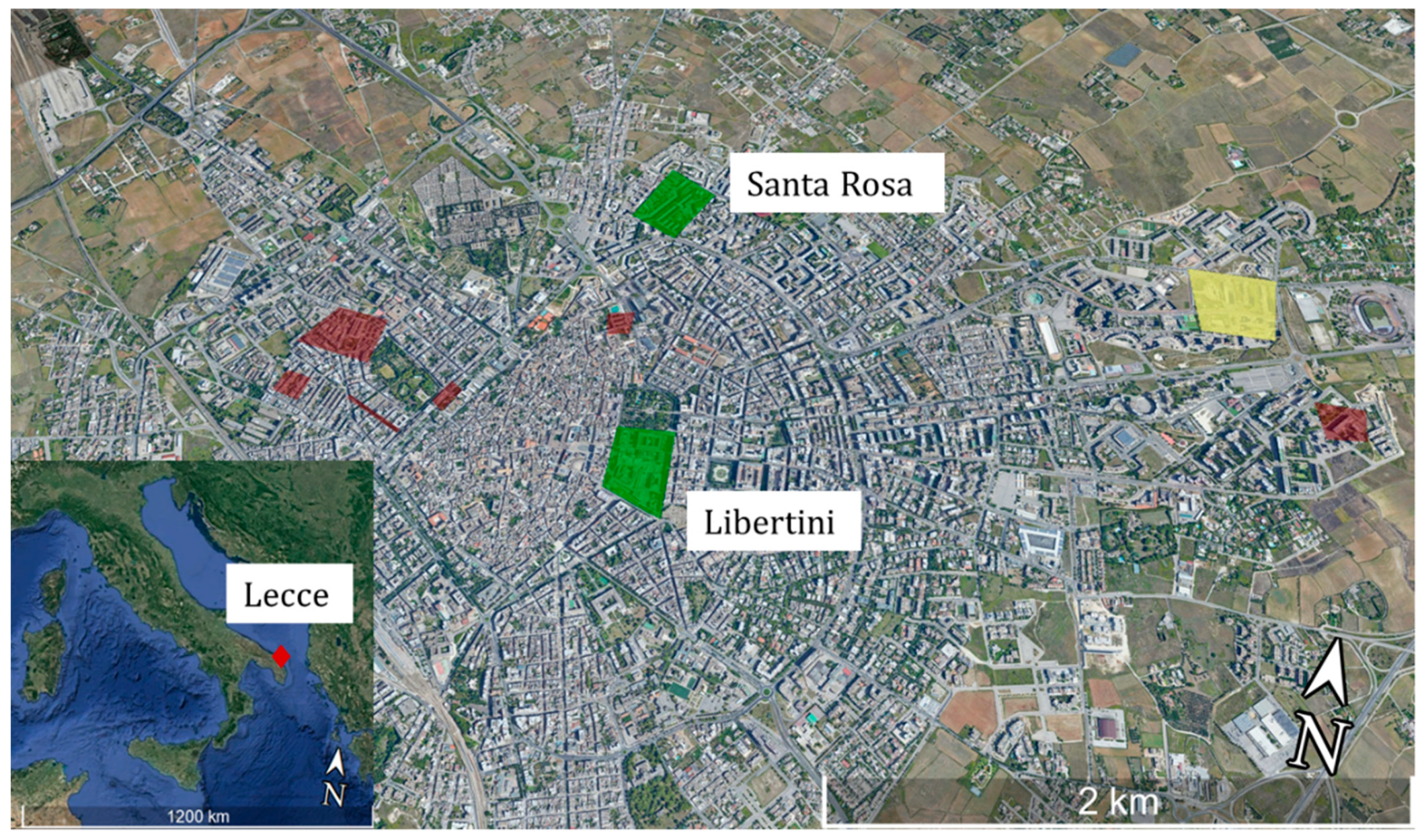
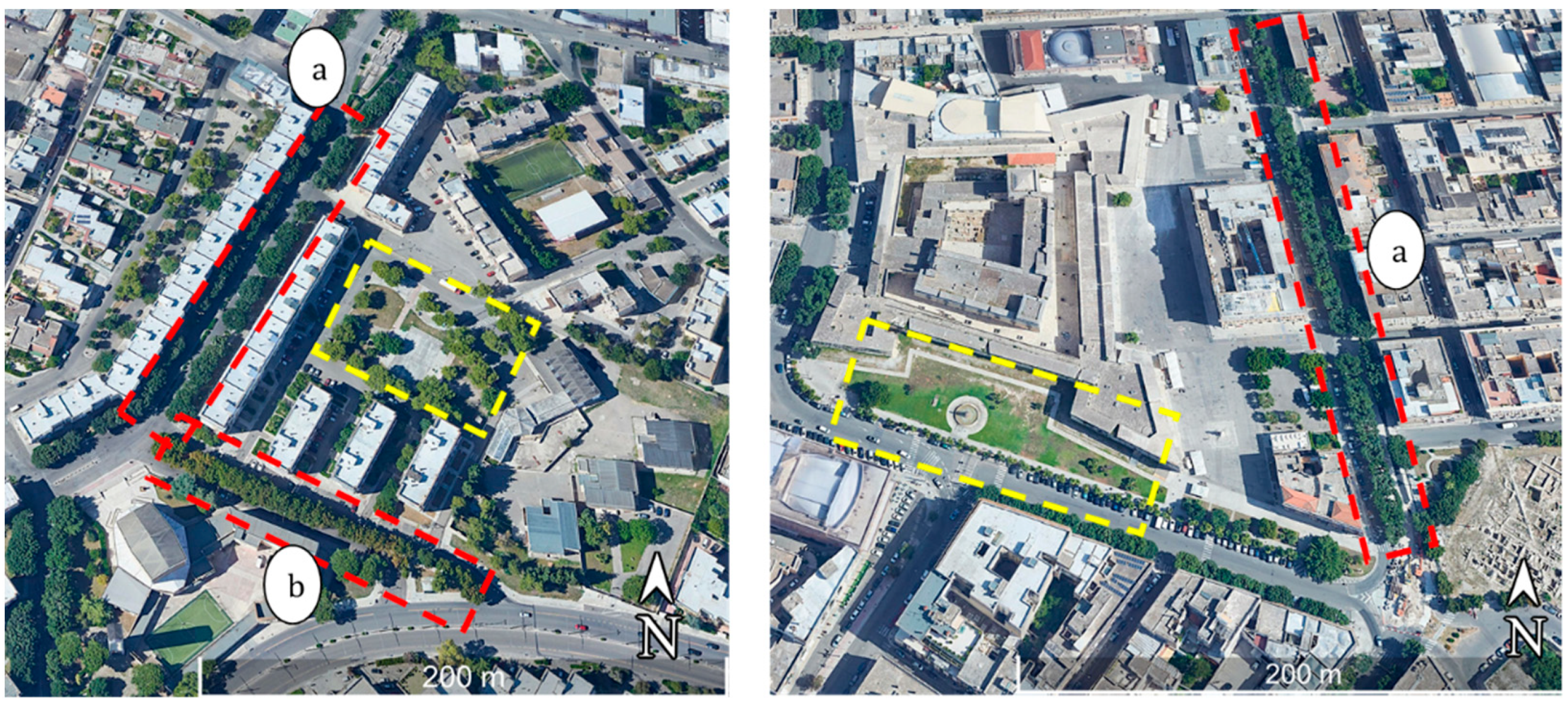
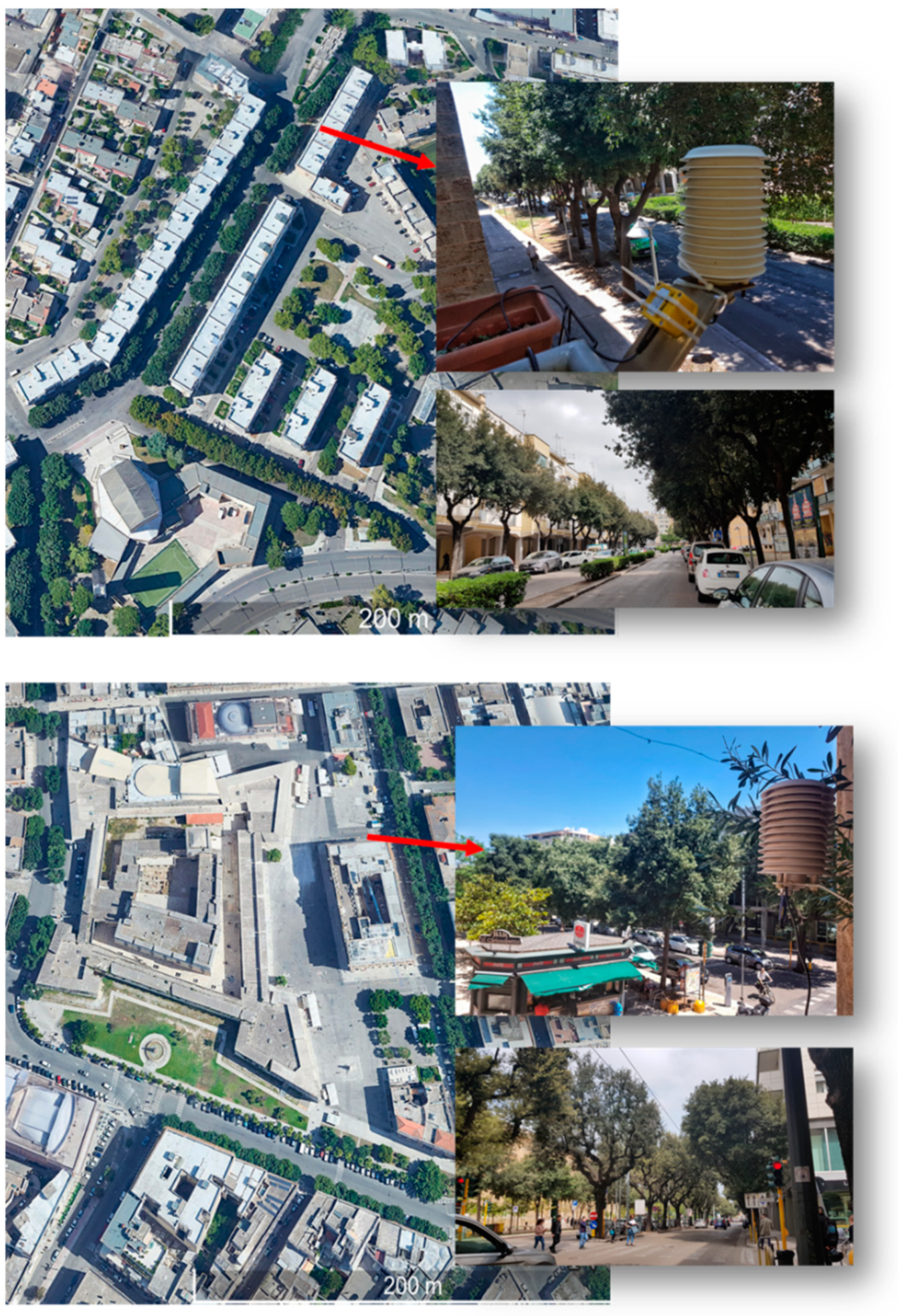
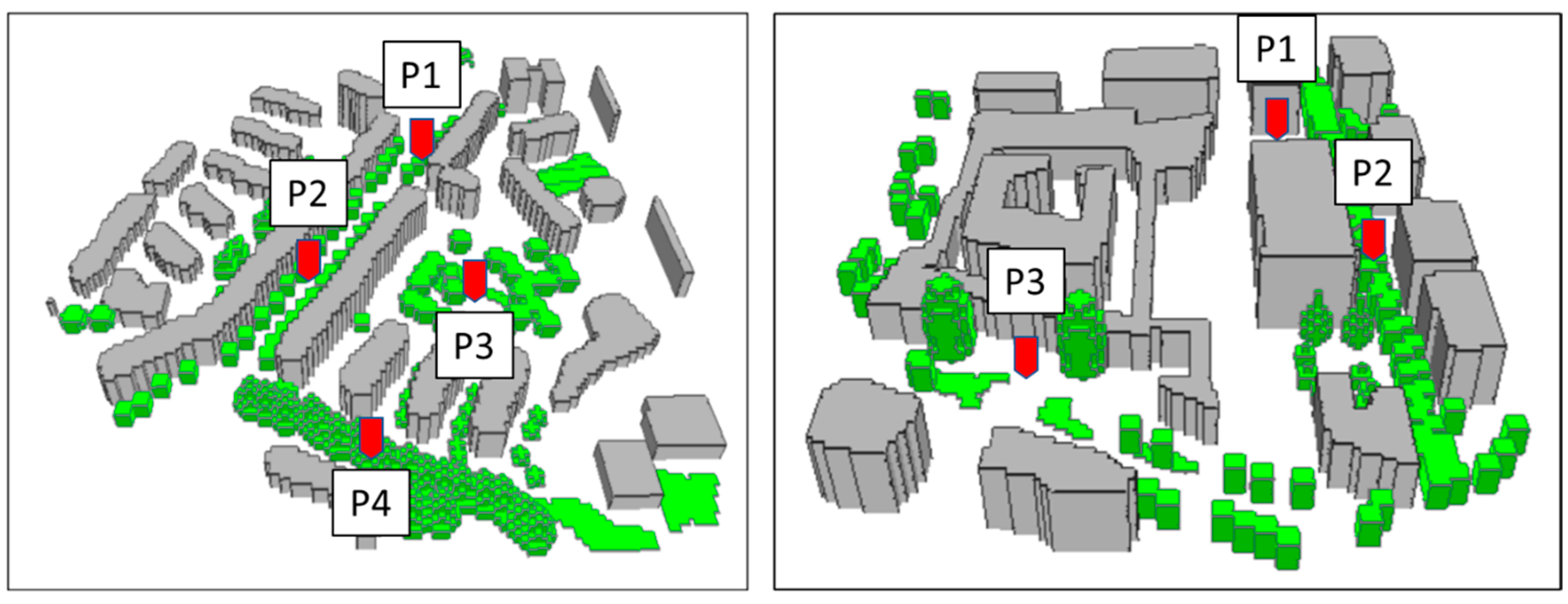
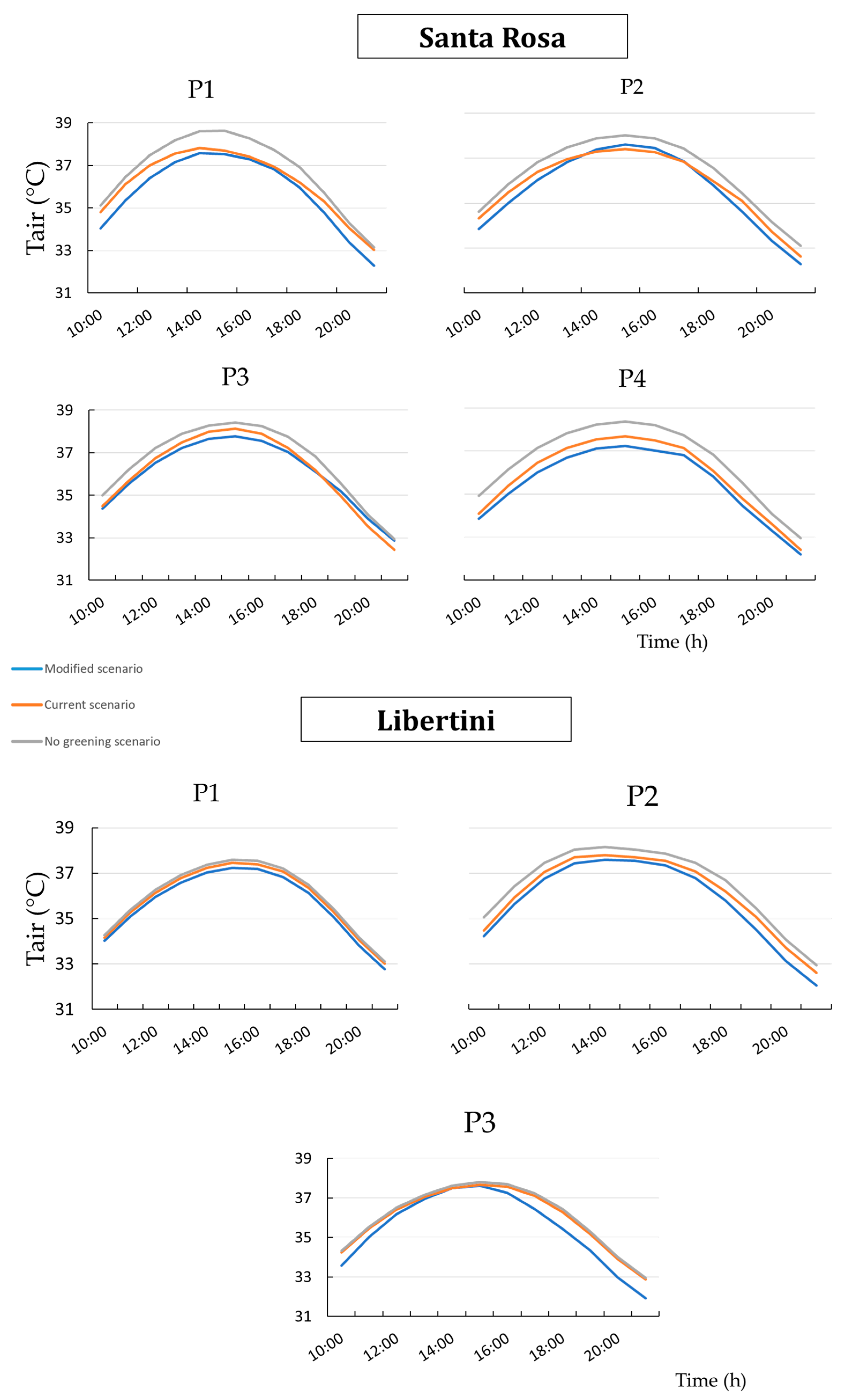
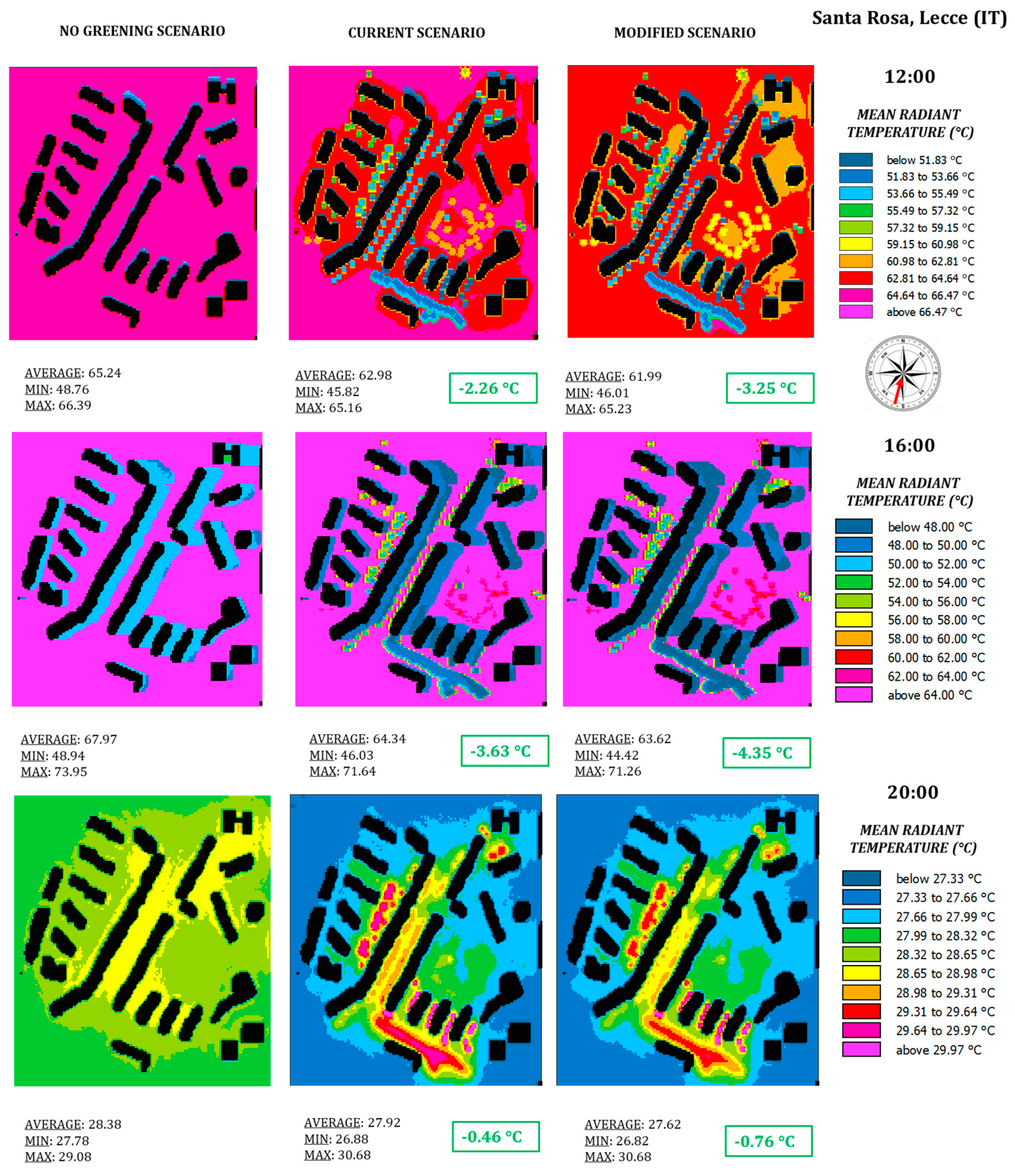


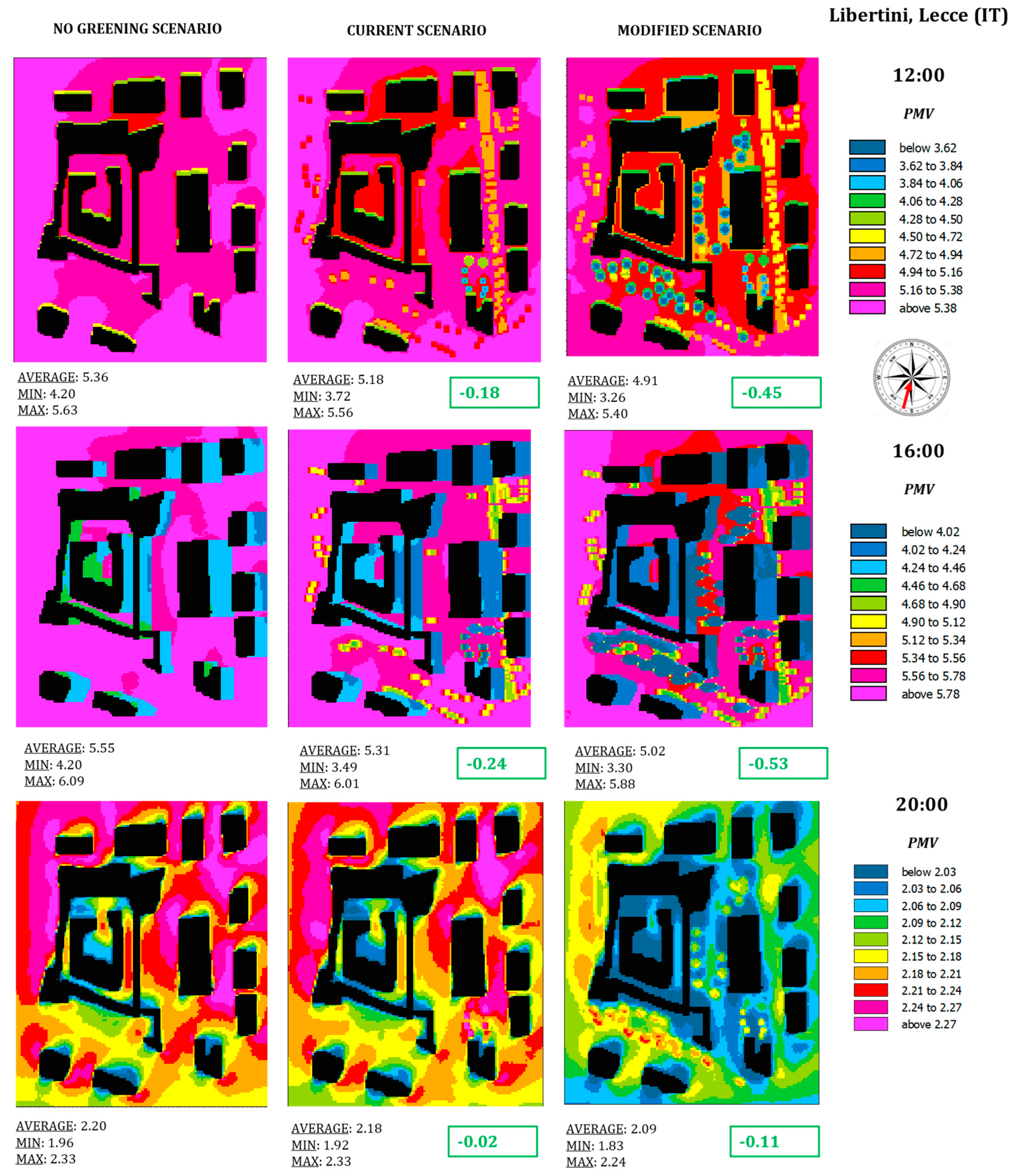
| Parameter | Definition | Value | |
|---|---|---|---|
| Simulation Time | Start Date | 12 June 2018 | |
| Start of simulation (h) | 05:00 | ||
| Total simulation time | 16 h (4 h spin-up + 12 h) | ||
| Meteorological conditions | Wind speed | 0.9 m/s | |
| Wind direction | 210° | ||
| Temperature of atmosphere (forced) | Daily profile | ||
| Relative humidity (%) (forced) | Daily profile | ||
| initial temperature (K) and relative humidity (%) of deep layer below 0.5 m | 293–60 (default values) | ||
| Computational domain and grid | Grid cells (x,y,z) | 150 × 150 × 30 | Santa Rosa |
| 125 × 150 × 30 | Libertini | ||
| δx × δy × δz | 2 m × 2 m × 2 m (equidistant: 5 cells close to the ground) | ||
| Nesting grids | 5 | ||
| Boundary conditions | Cyclic | ||
| Statistical Parameter | Santa Rosa | Libertini | ||
|---|---|---|---|---|
| Sim. | Meas. | Sim. | Meas. | |
| Mean | 29.74 | 27.38 | 29.85 | 28.81 |
| St.dev. | 3.79 | 3.46 | 3.58 | 3.26 |
| Higher | 35.53 | 33.05 | 34.99 | 33.62 |
| NMSE | 0.01 | 0.00 | ||
| FB | −0.08 | −0.04 | ||
| R | 0.92 | 0.91 | ||
| Santa Rosa | Libertini | |||||||||
|---|---|---|---|---|---|---|---|---|---|---|
| Street Canyon “a” | Street Canyon “b” | Square | Street Canyon “a” | Square | ||||||
| CS | MS | CS | MS | CS | MS | CS | MS | CS | MS | |
| 12:00 | 11% | 16% | 17% | 20% | 11% | 12% | 6% | 10% | 2% | 9% |
| 16:00 | 15% | 20% | 23% | 24% | 15% | 16% | 6% | 11% | 3% | 14% |
| 20:00 | 3% | 1% | 3% | 1% | 3% | 4% | 0.4% | 6% | 0.4% | 2% |
Publisher’s Note: MDPI stays neutral with regard to jurisdictional claims in published maps and institutional affiliations. |
© 2021 by the authors. Licensee MDPI, Basel, Switzerland. This article is an open access article distributed under the terms and conditions of the Creative Commons Attribution (CC BY) license (https://creativecommons.org/licenses/by/4.0/).
Share and Cite
Gatto, E.; Ippolito, F.; Rispoli, G.; Carlo, O.S.; Santiago, J.L.; Aarrevaara, E.; Emmanuel, R.; Buccolieri, R. Analysis of Urban Greening Scenarios for Improving Outdoor Thermal Comfort in Neighbourhoods of Lecce (Southern Italy). Climate 2021, 9, 116. https://0-doi-org.brum.beds.ac.uk/10.3390/cli9070116
Gatto E, Ippolito F, Rispoli G, Carlo OS, Santiago JL, Aarrevaara E, Emmanuel R, Buccolieri R. Analysis of Urban Greening Scenarios for Improving Outdoor Thermal Comfort in Neighbourhoods of Lecce (Southern Italy). Climate. 2021; 9(7):116. https://0-doi-org.brum.beds.ac.uk/10.3390/cli9070116
Chicago/Turabian StyleGatto, Elisa, Fabio Ippolito, Gennaro Rispoli, Oliver Savio Carlo, Jose Luis Santiago, Eeva Aarrevaara, Rohinton Emmanuel, and Riccardo Buccolieri. 2021. "Analysis of Urban Greening Scenarios for Improving Outdoor Thermal Comfort in Neighbourhoods of Lecce (Southern Italy)" Climate 9, no. 7: 116. https://0-doi-org.brum.beds.ac.uk/10.3390/cli9070116









